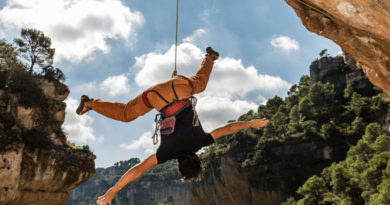Is There A Weight Limit For Rock Climbing?
There is no specific weight limit for rock climbing, as it is a sport that can be enjoyed by people of all shapes and sizes. However, body weight can affect a climber’s ability to perform certain moves and techniques, as well as their endurance and overall physical fitness.
For example, a heavier climber may find it more difficult to do certain dynamic moves that require explosive power or climb for extended periods due to the added strain on their muscles and joints. On the other hand, a lighter climber may have an advantage in certain types of climbing, such as technical face climbing, where strength-to-weight ratio can be an important factor.
Ultimately, the most important factor in rock climbing is technique and experience rather than weight. Climbers of all weights and sizes can succeed at the sport with proper training, practice, and a focus on safety.
Body Weight and Climbing Performance
Body weight is a significant factor influencing a climber’s performance in rock climbing. Climbing requires the use of various muscle groups, and a climber’s weight can affect their ability to execute various climbing techniques. Heavier climbers may struggle to perform dynamic moves that require explosive power, such as jumping to a hold or performing a dynamic move between two holds. This is due to the fact that their weight puts more strain on their muscles and joints, making it more difficult to generate the necessary force to execute the move.
Lighter climbers, on the other hand, may have an advantage in technical face climbing, where strength-to-weight ratio is an important factor. Technical face climbing necessitates a high level of balance, precision, and agility. A lighter climber produces less force, but their lightness allows them to be more agile and balanced on the rock. In other words, while they may lack the raw power to perform dynamic moves, they may be capable of performing more delicate and precise movements that require finesse.
It is important to note, however, that body weight is not the only factor that influences climbing performance. Experience, skill, and training are all essential. Climbers who have honed their technique and are experienced can often overcome the limitations imposed by their body weight. Furthermore, a climber’s fitness level, flexibility, and endurance all play important roles in their ability to climb well.
Safety Considerations
Body weight is one of the factors that can affect a climber’s safety when it comes to rock climbing. The amount of stress placed on a climber’s muscles and joints by their weight can increase the risk of injury. A heavier climber, for example, may be more prone to tendonitis or other types of overuse injuries due to the additional strain on their joints.
Furthermore, a climber’s weight can have an impact on their ability to execute certain types of climbing techniques safely. A heavier climber, for example, may find it more difficult to control their body position while performing a mantle or a high step. Because of their weight, they may be more prone to pendulum swings or falls.
Climbers of all weights should take safety precautions when climbing. Climbers should always climb with a partner, wear proper safety equipment such as a helmet and harness, and be familiar with the climbing area and route they intend to attempt. Climbers should also be aware of their own physical limitations and take breaks or rest when needed to avoid fatigue and overuse injuries.
Climbers who are overweight or obese should consult with a healthcare provider before beginning to climb. Climbing can be a physically demanding sport, so make sure your body is in good enough shape to withstand the physical stresses of climbing. Climbers who are overweight or obese may also benefit from working with a climbing coach or trainer to create a training plan tailored to their body type and fitness level.
Indoor Climbing Weight Limit
Indoor rock climbing facilities generally do not have specific weight limits for climbers. However, the weight of a climber can impact their safety and the safety of others, so it is important for climbers of all weights to take appropriate safety precautions.
Indoor climbing facilities typically require climbers to wear a harness and use a belay system to ensure their safety. The belay system involves one person on the ground or at the base of the climb controlling the rope for the climber. The person controlling the rope must be able to safely manage the weight of the climber and prevent falls or accidents. If the climber is significantly heavier than the belayer, the belayer may struggle to control the rope, potentially resulting in a safety issue.
Breaking Down Stereotypes
There are many stereotypes about body weight and rock climbing that can discourage people from pursuing the sport. Some people believe that only lean and muscular people can excel at rock climbing, whereas others believe that their weight is a barrier to entry. These stereotypes can be harmful and exclusionary, and they fail to reflect the diversity of rock climbers.
It is important to break down these stereotypes and promote inclusivity in rock climbing. Climbing is a sport that people of all shapes, sizes, and fitness levels can enjoy. While a climber’s body weight has an effect on their performance and safety, it is not the only factor that determines their success in the sport.
There are many successful climbers of various weights and body types. Lynn Hill, one of history’s most accomplished climbers, is known for her lean and muscular physique. Climbers of larger stature, such as Nikki Smith, have also found success in the sport. Smith, who weighs more than 200 pounds, has completed several difficult climbs and has become a proponent of body positivity in the climbing community.
It is critical to create a welcoming and inclusive environment in climbing gyms and outdoor climbing areas, in addition to highlighting successful climbers of all weights. This can be accomplished by promoting diversity in advertising and marketing, providing programs and classes that cater to various body types and fitness levels, and making climbing areas accessible and welcoming to all.
Conclusion
To conclude, there is no specific weight limit for rock climbing, whether it is indoor or outdoor climbing. However, a climber’s weight can have an impact on their performance and safety, so climbers must take appropriate safety precautions and be aware of their physical limitations. It is also critical to dispel myths about body weight and rock climbing and to promote inclusivity in the sport. Climbing is a sport that people of all shapes and sizes can enjoy, and creating a welcoming and supportive community for climbers of all backgrounds is critical for the sport’s growth and success. We can ensure that everyone has the opportunity to experience the joy and challenge of rock climbing in a safe and supportive environment by celebrating diversity and promoting inclusivity.




